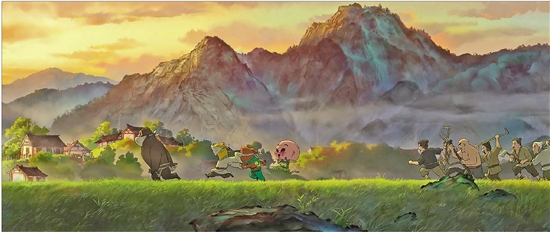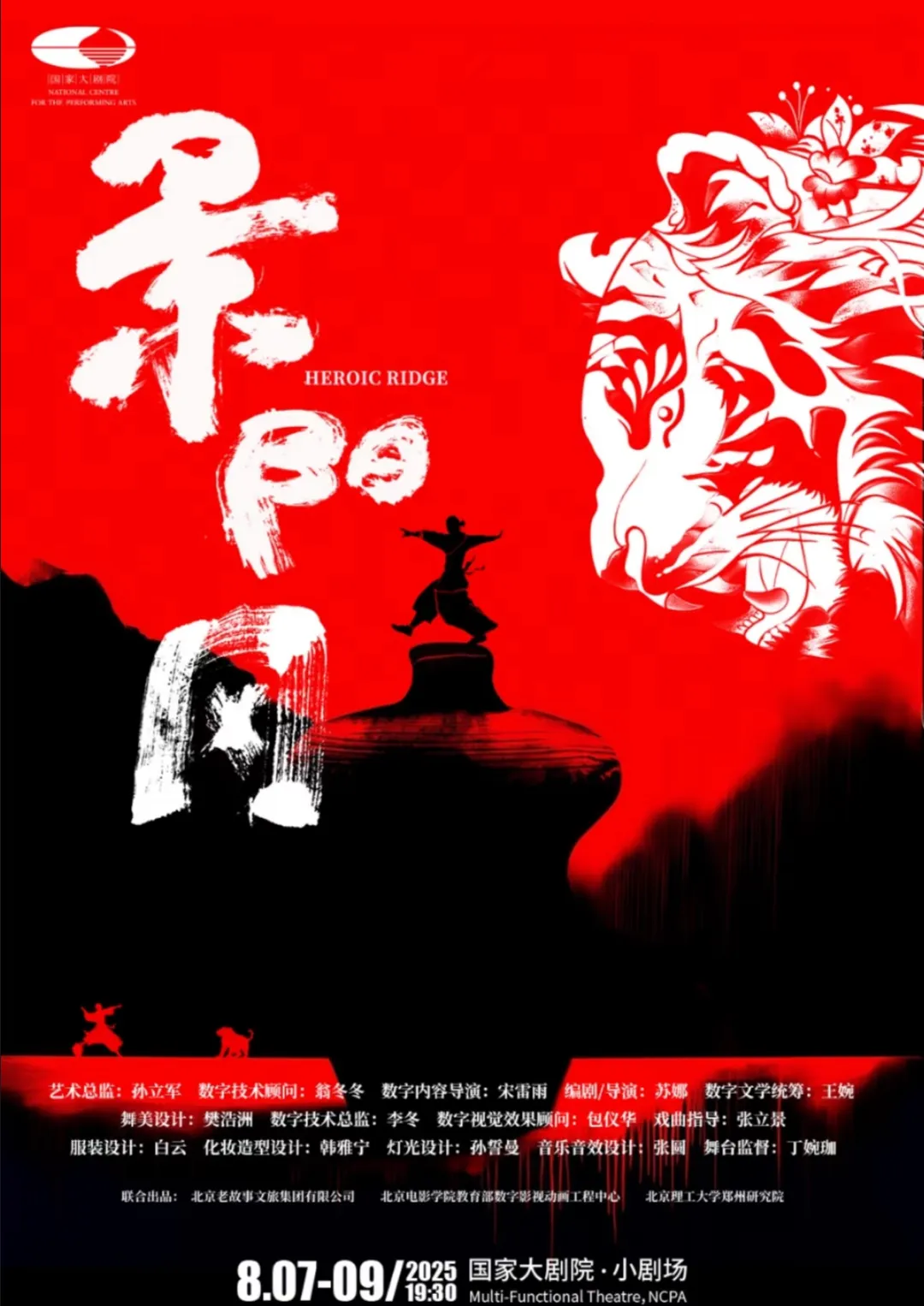
Stills from “The Little Monster of Langlang Mountain”.
Chinese animated films have traversed a century of history, and 2025 is destined to be an extraordinary year. Earlier this year, “Nezha: The Devil Boy Conquers the Dragon King” set a box office record of over 15 billion yuan, injecting strong momentum into the Chinese animated film industry. This summer, three domestically produced animated films, “Little Monsters of Langlang Mountain,” “Liao Zhai: The Lanruo Temple,” and “The Legend of Luo Xiaohei 2,” debuted in quick succession. With diverse themes, innovative styles, and precise positioning, these films have created a wave of excitement in the market, becoming a key pillar of the summer box office and providing new insights into the development of Chinese animation.
“Little Monster of Langlang Mountain”:
Fusion of tradition and present
A masterpiece from the Shanghai Animation Film Studio, “Little Monsters of Langlang Mountain” has garnered significant attention since its release, surpassing 300 million yuan at the box office in its first weekend, becoming a dark horse among summer animated films. This film not only continues the fine traditions of the Shanghai Animation Film Studio but also showcases its innovative energy in keeping with the times, allowing audiences to witness the renewed vitality of this established animation studio.
As a benchmark for Chinese animation, Shanghai Animation Film Studio has produced works such as “Havoc in Heaven” and “Nezha Conquers the Dragon King,” which feature a predominantly ethnic style. These themes often draw from traditional Chinese culture, and their artistic expression is deeply rooted in traditional fine arts. From line drawing to color, they exude a rich Chinese flavor. “Little Monsters of Langlang Mountain” inherits this charm, employing a freehand brushwork style in its set design. The mountain peaks are outlined with simple yet powerful lines, while the misty landscapes are smudged with ink, creating an aesthetic atmosphere of “brushwork and ink in the mirror.” The film’s artistic style eschews traditional flamboyance, instead showcasing a homely and unpretentious aesthetic.
The film’s character design breaks with convention; none of the characters are conventionally handsome. The protagonist, a pig demon, has a chubby figure, a flat nose, and narrowed eyes, creating a naive yet somewhat comical look. This slightly off-putting look perfectly reflects the director’s unique sense of humor. While studying at the Beijing Film Academy, the director demonstrated the observational and optimistic outlook unique to animators. For example, scenes like “Second Brother, the master has been captured by a demon” are both down-to-earth and hilarious, making the audience laugh while experiencing the vividness and endearing characterizations. “The Little Monster of Langlang Mountain” tells the story of a pig demon who embarks on an adventurous journey to change his fate at the bottom of Langlang Mountain. In the film, the pig demon refuses to yield to power or retreat in the face of adversity, remaining steadfast in his commitment to kindness and justice. This portrayal of ordinary people pursuing their ideals and upholding their conscience resonates deeply with contemporary audiences. Many viewers said that they saw their own shadows in the little pig demon. The mood of working hard and longing for recognition in the workplace, and the persistence of not giving up in the face of various pressures in life, made people empathize.
If there are indeed “cuisines” within animated films, then “Little Monsters of Langlang Mountain” embodies the “authentic” roots of the Chinese animation school. It not only inherits the fine traditions of Chinese animation but also connects seamlessly with contemporary audiences, successfully resonating with them. After viewing the film, Mr. Chang Guangxi, a veteran of the Shanghai Animation Film Studio, remarked, “The studio’s old animation style has returned,” undoubtedly a testament to the film’s heritage and innovation.
“Liao Zhai: Lanruo Temple”:
Controversy and reflections on innovative attempts
“Liaozhai: Lanruo Temple” is a bold experiment in animation format, but it has also sparked considerable controversy. The chapter “The Taoist of Laoshan” employs a felt-like style. Thanks to AIGC technology, this style has been significantly simplified, resulting in a familiar and heartwarming visual experience for viewers. The film, comprised of six stories, attempts to create a series. This “short film compilation” format is unusual in conventional theatrical releases, a testament to the creators’ courage. The six stories are adapted from classic chapters from “Strange Stories from a Chinese Studio,” including “The Taoist of Laoshan,” “Princess Lotus,” and “Painted Skin.” Each story has its own distinct style and theme, yet they are cleverly linked together through the central plot of a scholar staying overnight at Lanruo Temple to listen to stories told by a demon, forming a cohesive whole. The focus of controversy among the market and audiences is mainly on the positioning of the film. The creators hope to attract both young and adult audiences. Chapters such as “The Taoist Priest of Laoshan” and “Lotus Princess” have light-hearted and humorous plots and brightly colored pictures, which are suitable for young audiences to watch; while subsequent works such as “Painted Skin” introduce topic discussions for contemporary adults, involving profound themes such as love, desire, and human nature, and the picture style tends to be heavy and profound.
However, this “both” positioning is often difficult to achieve. Theoretically, a “family-friendly” approach is a possible path to this goal. However, a family-friendly approach is not simply a fragmented combination. Classic “family-friendly” films like Disney’s “Snow White” and “The Lion King” and China’s “The Lotus Lantern” are loved by both adults and children because they have a unified core and a smooth narrative, rather than simply piecing together elements for different audiences. While “Liao Zhai: Lanruo Temple” is a bold attempt, its positioning and narrative cohesion need improvement.
The Legend of Luo Xiaohei 2:
Precise positioning in self-reform
As a highly anticipated sequel, “The Legend of Luo Xiaohei 2” lived up to its audience’s expectations, achieving a high score of 8.7 on Douban, the highest for an animated film this year, achieving both critical and box office success. Compared to the original film, “The Legend of Luo Xiaohei 2” boasts significant advancements in plot, visuals, and character development. Continuing the original film’s worldview and storyline, the film follows Xiaohei as he joins the Monster Spirit Guild and works with his master, Wuxian, to address an attack on the guild. The expanded plot introduces new villains and a mysterious organization, adding further suspense and conflict. Furthermore, the film further enriches the variety and abilities of the monsters, making the worldview more complete and multifaceted.
In terms of visual language, “The Legend of Luo Xiaohei 2” features more fluid and exciting action design and more sophisticated visual production. The film’s combat scenes, whether it’s Xiaohei’s close combat with enemies or the dazzling spells cast by various demonic spirits, are visually captivating. The director avoided the pursuit of “all or nothing” during the creative process, instead clearly defining his own direction, highlighting the rebellious, self-centered, and passionate elements of the film, precisely capturing the needs of the target audience. The film’s protagonist, Xiaohei, while adorable in appearance, possesses a rebellious spirit at heart. He defies traditional rules and constraints, daring to pursue his own ideals and justice. He has deeply resonated with young audiences, who see in him their own pursuit of freedom and individuality.
What are the implications of these three works?
Despite their distinct styles and fates, the three animated films released during the 2025 summer season offer valuable insights into the development of Chinese animated films. Both “Little Monsters of Langlang Mountain” and “Liao Zhai: Lan Ruo Temple” draw from traditional Chinese culture, the former set in mythology and the latter adapted from a classic novel. Meanwhile, “The Legend of Luo Xiaohei 2” constructs a brand-new fantasy world, showcasing the creative potential of young creators. Stylistically, “Little Monsters of Langlang Mountain” leans towards humor, “Liao Zhai: Lan Ruo Temple” is full of fantasy and mystery, and “The Legend of Luo Xiaohei 2” is passionate and inspirational. In terms of audience targeting, “Little Monsters of Langlang Mountain” and “Liao Zhai: Lan Ruo Temple” sought to appeal to a wider audience, while “The Legend of Luo Xiaohei 2” is precisely targeted at a younger audience. From 1986 to 2000, China had no theatrical animated films. Now, three major animated films are released in a single summer season, each finding its own creative breakthrough. This demonstrates the remarkable progress made by Chinese animated films. However, while summing up our achievements, we also need to calmly reflect on our shortcomings.
First, in terms of subject matter, Chinese animation has relatively few perspectives on the future, and there’s still significant room for improvement in exploration of themes like science fiction. While some science fiction animation has emerged in recent years, both quantity and quality need to be improved. We should encourage creators to explore bolder ideas and create more animated works about the future and technology, demonstrating the forward-looking and innovative nature of Chinese animation. Second, we need to deeply explore and cultivate the aesthetic appeal of Chinese animation. The Chinese aesthetics of the Chinese animation school is a valuable asset that deserves careful study and inheritance. In the context of globalization, especially in the era of AIGC, we must avoid blindly imitating foreign animation styles and be wary of the erosion of Western aesthetics. Instead, we must cultivate our own unique aesthetic system, allowing Chinese animation to shine uniquely on the global stage. Finally, in terms of execution, we must avoid rushing for quick results, releasing a work in less than a year, which could lead to the loss of valuable IP. Nor should we blindly pursue a protracted production process, with years or even decades to create a single work being the norm. We need to strike a balance between meticulous craftsmanship and a reasonable creative cycle, providing audiences with more excellent content.
The 2025 summer animated film craze continues, and the reflections it leaves on the Chinese animation industry are just beginning. By innovating within a legacy and forging ahead through exploration, I believe Chinese animated films will continue to diversify and create more world-renowned masterpieces.
(The author is the dean of the China Animation Research Institute at the Beijing Film Academy)
 [Double Gold Award Works Break Through the Circle: Leaping from the International Stage to the National Hall]
[Double Gold Award Works Break Through the Circle: Leaping from the International Stage to the National Hall]